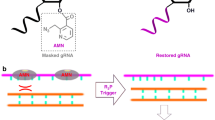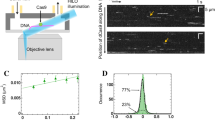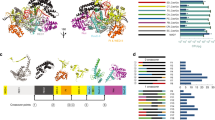Abstract
We demonstrate that by altering the length of Cas9-associated guide RNA (gRNA) we were able to control Cas9 nuclease activity and simultaneously perform genome editing and transcriptional regulation with a single Cas9 protein. We exploited these principles to engineer mammalian synthetic circuits with combined transcriptional regulation and kill functions governed by a single multifunctional Cas9 protein.
This is a preview of subscription content, access via your institution
Access options
Subscribe to this journal
Receive 12 print issues and online access
$259.00 per year
only $21.58 per issue
Buy this article
- Purchase on Springer Link
- Instant access to full article PDF
Prices may be subject to local taxes which are calculated during checkout


Similar content being viewed by others
Accession codes
References
Hsu, P.D., Lander, E.S. & Zhang, F. Cell 157, 1262–1278 (2014).
Sander, J.D. & Joung, J.K. Nat. Biotechnol. 32, 347–355 (2014).
Qi, L.S. et al. Cell 152, 1173–1183 (2013).
Mali, P., Esvelt, K.M. & Church, G.M. Nat. Methods 10, 957–963 (2013).
Fu, Y., Sander, J.D., Reyon, D., Cascio, V.M. & Joung, J.K. Nat. Biotechnol. 32, 279–284 (2014).
Jiang, W., Bikard, D., Cox, D., Zhang, F. & Marraffini, L.A. Nat. Biotechnol. 31, 233–239 (2013).
Chavez, A. et al. Nat. Methods 12, 326–328 (2015).
Esvelt, K.M. et al. Nat. Methods 10, 1116–1121 (2013).
Kiani, S. et al. Nat. Methods 11, 723–726 (2014).
Nissim, L., Perli, S.D., Fridkin, A., Perez-Pinera, P. & Lu, T.K. Mol. Cell 54, 698–710 (2014).
Li, Y. et al. Nat. Chem. Biol. 11, 207–213 (2015).
Davidsohn, N. et al. ACS Synth. Biol. 4, 673–681 (2015).
Dow, L.E. et al. Nat. Biotechnol. 33, 390–394 (2015).
Platt, R.J. et al. Cell 159, 440–455 (2014).
Perez-Pinera, P. et al. Nat. Methods 10, 973–976 (2013).
Maeder, M.L. et al. Nat. Methods 10, 977–979 (2013).
Chen, B. et al. Cell 155, 1479–1491 (2013).
Magoč, T. & Salzberg, S.L. Bioinformatics 27, 2957–2963 (2011).
Li, H. & Durbin, R. Bioinformatics 25, 1754–1760 (2009).
Li, H. et al. Bioinformatics 25, 2078–2079 (2009).
Li, B. & Dewey, C.N. BMC Bioinformatics 12, 323 (2011).
Law, C.W., Chen, Y., Shi, W. & Smyth, G.K. Genome Biol. 15, R29 (2014).
Smyth, G.K. Stat. Appl. Genet. Mol. Biol. 3, Article3 (2004).
Hoffman, R.A., Wang, L., Bigos, M. & Nolan, J.P. Cytometry Part A 81, 785–796 (2012).
Beal, J. Front. Bioeng. Biotechnol. 2, 87 (2015).
Acknowledgements
We thank K. Esvelt, J. Scheiman, J. Huh, J. Aach, M.K. Cromer, S. Haque, M. Tung and all the other members of the Church, Collins and Weiss labs for their assistance and insightful discussions. We also thank P. Mali at University of California San Diego (UCSD; San Diego, California, USA) for the HEK293T cells. The dSaCas9 plasmid was a generous gift from F.A. Ran, W.X. Yan and F. Zhang (Broad Institute–MIT, Boston, Massachusetts, USA). This work was supported by US National Institutes of Health National Human Genome Research Institute grant P50 HG005550, US Department of Energy grant DE-FG02-02ER63445, the Wyss Institute for Biologically Inspired Engineering, the US Army Research Office (DARPA W911NF-11-2-0054), the National Science Foundation (Emerging Frontiers in Research and Innovation Award in Engineering New Technologies Based on Multicellular and Inter-kingdom Signaling) and US National Institutes of Health grants 5R01CA155320-04 and P50 GM098792. A.C. acknowledges funding by the National Cancer Institute (grant 5T32CA009216-34). S.V. acknowledges funding by the National Science Foundation Graduate Research Fellowship Program, the Department of Biological Engineering at MIT and the Department of Genetics at Harvard Medical School. R.C. was funded by a Banting postdoctoral fellowship from the Canadian Institutes of Health Research. J.J.C. acknowledges funding from Defense Threat Reduction Agency grant HDTRA1-14-1-0006.
Author information
Authors and Affiliations
Contributions
S.K. and A.C. designed and performed experiments and analyzed data. M.T., R.N.H., R.C., D.T.-O. and J.Q. performed experiments and interpreted data. S.V. and B.W.P. developed tools and contributed expertise. E.J.K.K. contributed to the analysis of RNA-Seq data. J. Beal helped with the initial design of repression promoter constructs and analysis of data via the TASBE method. M.R.E. helped with the design of experiments and interpretation of data. J. Buchthal analyzed data. J.J.C., R.W. and G.C. supervised the study. A.C., S.K., M.T. and M.R.E. wrote the manuscript with the support of all the other authors.
Corresponding authors
Ethics declarations
Competing interests
G.C. is a cofounder of Editas Medicine, a company that uses CRISPR-Cas9 technology.
Integrated supplementary information
Supplementary Figure 1 Activation and cutting of a transcriptional reporter using gRNAs with progressively shorter 5ʹ end lengths.
(a) Deletion analysis of truncated gRNAs on a synthetic transcriptional reporter. Samples were transfected with the indicated Cas9 construct and gRNA. Data indicate the mean and s.e.m. (n = 2 independent transfections). (b) Quantification of activation for truncated gRNAs via a fluorescent transcriptional reporter. Data indicate the mean and s.e.m. (n = 2 independent transfections).
Supplementary Figure 2 Activation and cutting of a transcriptional reporter using orthogonal Cas9 proteins.
(a) Deletion analysis of truncated gRNAs on a synthetic transcriptional reporter using SA and ST1 Cas9. Samples were transfected with the indicated Cas9 construct and gRNA. Data indicate the mean and s.e.m. (n = 2 independent transfections). (b) Quantification of activation for truncated gRNAs via a fluorescent transcriptional reporter using SA and ST1 Cas9. Data indicate the mean and s.e.m. (n = 2 independent transfections).
Supplementary Figure 3 Activation and cutting of endogenous HBG1 gene.
RNA expression and mutagenesis analysis of the gene HBG1. Each sample was transfected with the indicated Cas9 construct and gRNA. Data indicate the mean and s.e.m (n = 2 independent transfections). *P < 0.05 when compared to the guide control for activation experiments.
Supplementary Figure 4 Mismatch comparison between 20-nt and 14-nt sgRNA activation using Cas9-VPR.
Comparison of activation of Cas9-VPR targeted to three tdTomato reporters using 20-nt or 14-nt gRNA with single mismatches at each position. Single-mismatch mutations are Watson-Crick transversions. The −1 position is adjacent to the PAM sequence. tdTomato reporter activation by Cas9-VPR was measured using flow cytometry, and values shown represent the ratio of the activation signal observed from each gRNA to fully matched gRNA. In other words, the 20-nt mismatched guides were normalized to the fully matched 20-nt gRNA and the 14-nt mismatched guides were normalized to the fully matched 14-nt gRNA. NM, no mismatches, or the fully matched gRNA samples. n = 2 independent biological replicates. Data represent the normalized median with error bars representing s.e.m.
Supplementary Figure 5 Off-target expression analysis.
(a) Gene expression levels (log2 TPM (transcripts per million)) in cells transfected with dCas9-VPR targeting the indicated genes with gRNAs of indicated lengths (y-axis) versus expression in cells transfected with gRNA only (x-axis). R indicates Pearson’s correlation coefficient calculated for log-transformed values on all genes except the target. A pseudocount of 1 TPM was added to each gene before log transformation. Average of two biological replicates shown. A one-way within-sample ANOVA was performed and demonstrated no significant difference in expression of nontargeted transcripts for truncated guides versus the full-length guide (P = 0.316). Correlation between samples and controls was also high (R ≥ 0.979). (b) Histograms showing the distribution of fold changes in gene expression (activator/guide control). Genes were filtered to include only those with TPM > 1. Average of two biological replicates shown.
Supplementary Figure 6 Pictorial representation of Figure 1d.
Cells were transfected with a 20-nt guide directed toward ACTC1, 14-nt guides directed toward MIAT and TTN and either Cas9-VPR or Cas9. This picture represents the expected behavior of Cas9-VPR. The ACTC1 locus should be cut, while transcription occurs for the genes MIAT and ACTC1.
Supplementary Figure 7 gRNA-mediated recruitment of an activator using Cas9.
The indicated constructs were transfected with a 20-nt ACTC1 gRNA and 14-nt MIAT and TTN gRNAs simultaneously with the indicated Cas9 and/or AD. Activation in this experiment occurred not through direct fusion to Cas9, but through an aptamer-based system in which the effector was recruited to the gRNA. Data indicate the mean and s.e.m. (n = 2 independent transfections). *P < 0.05 when compared to the guide control.
Supplementary Figure 8 Simplified schematics of circuits in Figure 2.
(a) Schematic of a Cas9-VPR and 14-nt gRNA repression device. (b) Schematic of parallel Cas9-VPR/14-nt gRNA–based transcriptional repression and activation devices in a single cell. A 14-nt gRNA-c drives Cas9-VPR to a CRISPR-activatable promoter (CAP) and mediates the activation of tdTomato while another 14-nt gRNA targets Cas9-VPR to a CRISPR repressible promoter (CRP) to repress EYFP expression. (c) Schematics of a genetic kill switch designed to incorporate Cas9-VPR DNA cleavage and transcriptional activation functions. A 14-nt gRNA directs Cas9-VPR to a CAP to activate output EYFP expression. Addition of doxycycline generates a 20-nt gRNA that directs Cas9-VPR to the same region in the promoter but cuts within the promoter, thereby decreasing EYFP output. (d) Genetic kill circuit that incorporates all three functions of Cas9-VPR: DNA cleavage, transcriptional activation and repression. Input gRNA that cuts within TALER coding sequences decreases available gRNA-a and reduces output expression.
Supplementary Figure 9 Building different promoter architectures to analyze Cas9-VPR–mediated transcriptional repression.
(a) Schematics of Cas9-VPR/14-nt gRNA–based transcriptional repression control unit. (b) Architecture of different CRISPR repressible promoters (CRPs). We developed a library of CRPs containing various numbers of gRNA target sites at different locations relative to the transcriptional start site in minimal CMV promoter or various numbers of upstream activation sites (UAS), in order to identify promoter architectures that allowed us to achieve efficient Cas9-VPR–mediated transcriptional repression. (c) Geometric mean and s.d. of means of EYFP for cells expressing >107 MEFL of transfection marker EBFP (n = 3 technical replicates). The highest repression was achieved with CRP-8. Some of the promoters designed for repression purposes unexpectedly led to activation, and further analysis is required to understand the effect of spacing between Cas9-VPR target sites at the promoters or location of targeting (downstream of the promoter) on this observation. Note CRP-a in the schematics of (a) is CRP-8.
Supplementary Figure 10 Analysis of dynamics of a genetic kill-switch circuit.
(a) A schematic of a genetic kill switch designed such that 20-nt and 14-nt gRNAs compete for same target site within a CAP (CRISPR-activatable promoter). Upon induction of 20-nt gRNA and infrared fluorescent protein (iRFP) with doxycycline, a reduction in EYFP expression is expected as a result of cleavage mediated by Cas9-VPR and 20-nt gRNA within the CAP. (b) 14-nt gRNA and Cas9-VPR–mediated activation of EYFP is detectable around 24 h after transfection and continues through 96 h. The control group received only the transfection marker EBFP and was measured 48 h after transfection. Data are the geometric mean and s.d. of means of EYFP for cells expressing >2 × 107 MEFL of transfection marker EBFP. (c) After the addition of doxycycline, cells positive for iRFP and 20-nt gRNA expression were detectable around 24 h after transfection and remained high in iRFP expression until 96 h. Shown are the percentages of cells expressing EBFP>107 MEFL and iRFP>106.5 relative to the uninduced population. (d) Fraction of cells that had EYFP above autofluorescence relative to the uninduced population in different treatment conditions and over time. Shown are the percentages of cells expressing EBFP>107 MEFL and EYFP>105.5 relative to the uninduced population. (e) Bars show the geometric mean ratio and s.d. of the mean ratio of uninduced versus fully induced samples, for cells expressing >107 MEFL of transfection marker EBFP. Group 1 includes cells that received doxycycline (4,000 nM) at the time of transfection, and group 2 includes cells that received doxycycline 24 h after the transfection. We observed a slower dynamic in group 2, possibly because of the initial accumulation of EYFP protein. For all figures, n = 3 independent technical replicates combined from three experiments.
Supplementary Figure 11 Understanding the design rules based on the concentrations of Cas9-VPR, 14-nt gRNA and 20-nt gRNA.
(a) A schematic of a genetic kill switch designed such that 20-nt and 14-nt gRNAs compete for same target site within a CAP. (b) Varying the dosages of transfected plasmids encoding Cas9-VPR, 14-nt gRNA, and 20-nt gRNA between low (5 ng), medium (25 ng for 14-nt gRNA and 50 nt for 20-nt gRNA) and high (250 ng) helped us unravel some design rules. Each line represents a single condition of transfection with corresponding Cas9, 14-nt gRNA and 20-nt gRNA plasmid levels in front of the fold change observed upon the addition of doxycycline. Bar graphs show the fold change of the geometric mean and s.d. of means of EYFP over uninduced cells for cells expressing >3 × 107 MEFL transfection marker EBFP. n = 3 independent technical replicates combined from three experiments.Cas9 in the footnote of the colored map refers to the concentration of Cas9-VPR complex.
Supplementary Figure 12 Design and analysis of a genetic kill switch that functions based on DNA cleavage in the Cas9-VPR coding sequence.
(a) A schematic of a genetic kill switch designed such that the presence of 20-nt gRNAs leads to Cas9-VPR–mediated cleavage within its own coding sequence and thereby reverses the output EYFP and tdTomato levels. Cas9-VPR targets a CAP by means of 14-nt gRNA-c, leading to activation of tdTomato expression. In parallel, Cas9-VPR and 14-nt gRNA-a also target a CRP, where Cas9-VPR binding provides a steric barrier to EYFP transcription. In the presence of a pair of full-length 20-nt gRNAs targeting the middle of the Cas9-VPR coding sequence, the guides direct Cas9-VPR to cut and disable itself and, by doing so, decrease the available pool of Cas9-VPR in the cell, ultimately causing a reduction of reporter inhibition or activation. Comparing cells that either received two pairs of 20-nt gRNAs that cuts with Cas9-VPR coding region or did not, we observed about fivefold de-repression of EYFP and about a 1.4-fold decrease in tdTomato expression. Shown are the geometric mean and s.d. of means of EYFP and tdTomato for cells expressing >107 MEFL transfection marker EBFP. n = 4 independent technical replicates combined from three experiments.
Supplementary Figure 13 Design and analysis of a genetic kill switch that operates based on DNA cleavage in the TALER coding sequence and reversal of a transcriptional repression device.
(a) Schematics of the kill switch involving a TALER-based transcriptional repression device and Cas9-VPR–mediated DNA mutation within the TALER DNA sequence. We tested whether Cas9-VPR can cleave within the TALER coding sequence and, by doing so, decrease available TALER, thus removing its repression of EYFP. Analysis of this switch using 20-nt gRNA against different regions within the TALER sequence allowed us to achieve a moderately functional kill switch (b). Shown are the geometric mean and s.d. of means of EYFP for cells expressing >107 MEFL of transfection marker EBFP (n = 3 technical replicates). T1–4 refer to 20-nt gRNAs that cut at different regions in the TALER coding sequence.
Supplementary Figure 14 Design and analysis of a genetic kill switch that operates based on DNA cleavage in the TALER coding sequence and reversal of a transcriptional repression device.
(a) Schematics of the layered kill switch. We generated a modified U6 promoter, regulated by TALER, enabling us to connect the genetic kill switch in Supplementary Figure 13 with a Cas9-VPR 14-nt gRNA repression device. Transfection of this circuit in HEK293FT cells exhibited repression of output EYFP upon addition of a pair of input 20-nt gRNAs that cut within the TALER coding sequence. (b) Shown are the geometric mean and s.d. of means of EYFP for cells expressing >107 MEFL of transfection marker EBFP. Output is compared between cells with or without gRNA encoding plasmids that cut within TALER coding sequences (n = 3 technical replicates).
Supplementary information
Supplementary Text and Figures
Supplementary Figures 1–14 and Supplementary Notes 1–4 (PDF 2141 kb)
Supplementary Data
Figure data. (XLSX 236 kb)
Rights and permissions
About this article
Cite this article
Kiani, S., Chavez, A., Tuttle, M. et al. Cas9 gRNA engineering for genome editing, activation and repression. Nat Methods 12, 1051–1054 (2015). https://doi.org/10.1038/nmeth.3580
Received:
Accepted:
Published:
Issue Date:
DOI: https://doi.org/10.1038/nmeth.3580
This article is cited by
-
CasKAS: direct profiling of genome-wide dCas9 and Cas9 specificity using ssDNA mapping
Genome Biology (2023)
-
mRNA trans-splicing dual AAV vectors for (epi)genome editing and gene therapy
Nature Communications (2023)
-
Design principles for synthetic control systems to engineer plants
Plant Cell Reports (2023)
-
High-yield genome engineering in primary cells using a hybrid ssDNA repair template and small-molecule cocktails
Nature Biotechnology (2023)
-
HideRNAs protect against CRISPR-Cas9 re-cutting after successful single base-pair gene editing
Scientific Reports (2022)



